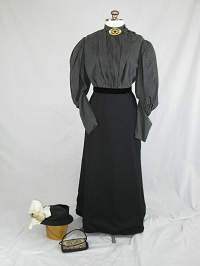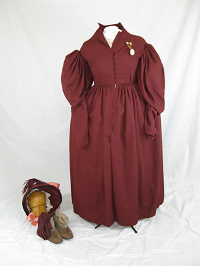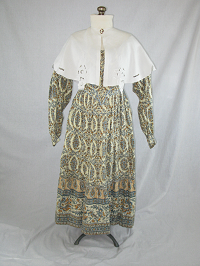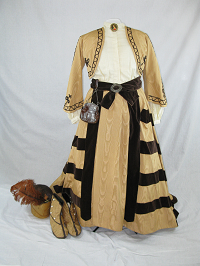
- Details
- Category: 19th century
- Hits: 2458
1890s
The shirt waist and navy skirt was appropriate for the "working girls" who staffed the business offices of the late 19th century. The bodice has a semi-full sleeve with wide cuffs. The front closes with hooks and eyes and there is a cameo at the neckline. Every woman had several pins to be used at the neck of her gowns. Paper cuffs would protect the sleeves while working and could be thrown out. A serviceable dark wool was chosen to make the popular slim skirt with the fullness in the back which flows out as she walks.
Click photo for detailed views.
- Details
- Category: 19th century
- Hits: 2541
1832
With the 1830s came the romantic era which was a time of cleanliness and scented soaps and toilet water. Cosmetics consisted of lampblack for mascara and a wet, red ribbon for a delicate rose tint to the cheeks. They would bite their lips vigorously before entering a room to add lip color. The newspapers of the 1830s advertised the arrivals of models of the newest fashions from France in the form of paper dolls with elegant morning, evening, and dinner dresses, headresses, hats and caps.
This travel outfit is of maroon wool. The beaver hat has a white veil. Can't you see her galloping across the fields with the veil flying in the wind. Of course she would ride side saddle. This fashionable riding outfit from 1832 has sloping shoulders, a long full skirt, and a close fitting bodice which hooks up the front. Front boning and cording in all seams are also typical of this period. The outfit is completely lined and has extra braid along the hem to prevent wear in this area. The large "Gigot" sleeves needed support in the form of horsehair, whaleboning, or pads tied inside each sleeve.
This gown would be worn over a thin overdress. Worn over the corset, chemise, as many as five petticoats were needed to achieve the 5-foot diameter that was in fashion at this time. The large rump has returned, but a Victorian lady never mentioned any part of her body, so it is now called a cushion. The neckline is filled with a lawn habit shirt with three neck ruffles. The chatelain pinned to the front is filled with smelling salts in case she feels faint and her penny purse will provide the boy who helps her onto her mount with his fee. Flat shoes in the form of ballet slippers or cloth boots were the fashion. Material used for stockings was often the same as the dress. Pink stockings with fishnet stockings over them gave the appearance of bare legs without actually exposing the leg.
Around the neck was placed a habit shirt. The neck ruffles are said to be flattering as they hide the first wrinkles of old age. Extra switches, braids, and curls were added when nature was deficient. A felt hat with a flowing veil presents a romantic picture, which is completed with leather gloves and a riding crop. The women when dressed would weigh 20 to 30 pounds more.
Click photo for detailed views.
- Details
- Category: 19th century
- Hits: 2571
1840s
The demure woman of the 1840s hid her complexion from the harsh sun with a parasol, bonnet and by overclothing herself. Gowns were shaped largely by the heavy underclothes beneath. This day dress is typical of the time with its full skirt and bottom flounce. The long full skirts exposed a tiny toe, no more. We have used a blue paisley Waverly reproduction print. The waistline has returned to its normal position and is now pointed just in the front. Seams become important details and are accented with blue cording. The brimmed bonnet, trimmed with ribbon and flowers, protects from the sun, as does the pelerine. Many ladies wore low corsages but did not leave the neck exposed. To serve this purpose, a pelerine of white was constructed. The cap is sheer material trimmed in yards of lace. The lace frames the face and can be seen when worn under the bonnet.
Click photo for detailed views.
- Details
- Category: 19th century
- Hits: 2730
1897
This afternoon suit is a peaches and cream confection of taffeta, organza and lace. The term suit applied to a set of garments intended to be worn together and the word was commonly used for what we call dresses today. The skirt now fits tightly to the hips, flows gently to the floor, and is decorated around the bottom. Favored materials were silk warp wool challis, cashmeres and taffetas. Transparent fabrics were used for the blossoms, ruffles, and rosettes which trailed across the skirts and up the bodice. In 1897 fashion went into a transition. The emphasis on the shoulder was reduced to a kind of epaulette over slim sleeves with some gathers at the top. Edgings were seen at the wrists. Fullness moved to the bodice and there developed a "chest out" look. This bosom enlarged further, early in the 20th century. This new fashion cycle featured the reverse-S silhouette. Bodices had high necks which were stiffened with boning to keep the head back and the chin out. Exaggerated fullness was added to the bodice front. A proper corset was essential to the fit of any period from girlhood to death, most women went about their daily activities encased in such a brace. Even the rural poor, donned them as a holiday luxury.
Materials were still firm except for the trimming. Wools such as alpaca, of which the original gown was constructed, as well as taffetas like this were popular. Much decorated bodices were firmly attached or mounted on tightly fitted, front hooked linings, then the outer part was closed by several hooks on the left side. To give a look of continuous neck band, the high collar hooks in the back. Epaulettes and shoulder frills emphasize a continued interest in the sleeve area. The waist was smaller in the 1890s than any other time in history. Corsets donned at least one hour before were pulled tighter when dressing. Slightly gored skirts had all the fullness gathered center back and there is a pocket in the opening for necessities. Artificial pads were no longer worn except where nature was deficient. Indoor caps were discarded in the 1870s except for night wear and by the 1890s the central heating made even them unnecessary. This is one of the newest outfits in the show and does not have the accessories. A well-dressed woman would need to be fashionable in the Gay 90s, such as her hat, a chatelain purse and silk undies.
Toward the end of the 1880s skirts had widened again and the close fitting sleeve began to balloon at the top until by 1895 the leg-o-mutton sleeve was in full sail. But the affluence of the times could not only be seen in the increased amount of clothing a woman owned but in the faster new styles were adopted and then discarded. In 1898 the sleeve had returned to a sensible shape.
Parasol of antique satin has cotton lace applied between the panels and along the edge. A puff of silk. Hat of straw, flowers, feathers, and tulle top the upswept hair styles. Gloves and a purse complete the illusion.
Click photo for detailed views.
- Details
- Category: 19th century
- Hits: 2566
1868
By the mid 1860s, the hoop gave way to renewed back interest. This required a new type of support for the skirts. Petticoats made of horse hair with tucked bottoms were donned then topped with a stuffed crinoline. When stuffed with eiderdown it made a cloudlike foundation. Ladies were said to float along. One topic of conversation was whether they really had legs under all this encumbrance. The new skirts were gored with flounces. Tan Moire was chosen to execute this 1868 walking dress. Crossways bands of dark brown velvet draw the eye back to the flounce, which is bound in velvet. Separates introduced during the 1850s allowed a skirt to have both a day and an evening bodice. In remodeling this outfit we added a new body or blouse and a jacket. The introduction of the short bolero jacket necessitated a bodice be added to the false sleeves shown before. These were called bodies. The art of insetting lace between two pieces of material became popular at this time, we purchased material woven with this design to save time.
The popular jacket of the 1860s was called the Figaro. Seventeen yards of braid were used to trim it. The pattern was seen in Peterson's Magazine. These magazines contained poems, art, stories, recipes, fashions and other sundry items of interest to the Victorian woman including news of the Civil War. A brown velvet sash covers the bands where the body and the skirt meet. This gown was patterned after one made in 1868 in England. In 1863, New York milliner Mrs. Cribbs, would construct a new bonnet for a measly $125. Popular during the Civil War, was a "pork pie" bonnet.
Godey's ladies book illustrated a quilted cloth boot, so one was fashioned to match this afternoon dress. Many editorials were written to disapprove of the new trains, especially while out walking on the unpaved streets. Necessity became the mother of invention. Tapes were added to the skirt so when out walking the train could be caught up. This back interest developed into a full fledged bustle in the 1870s.
Click photo for detailed views.
Page 9 of 13





